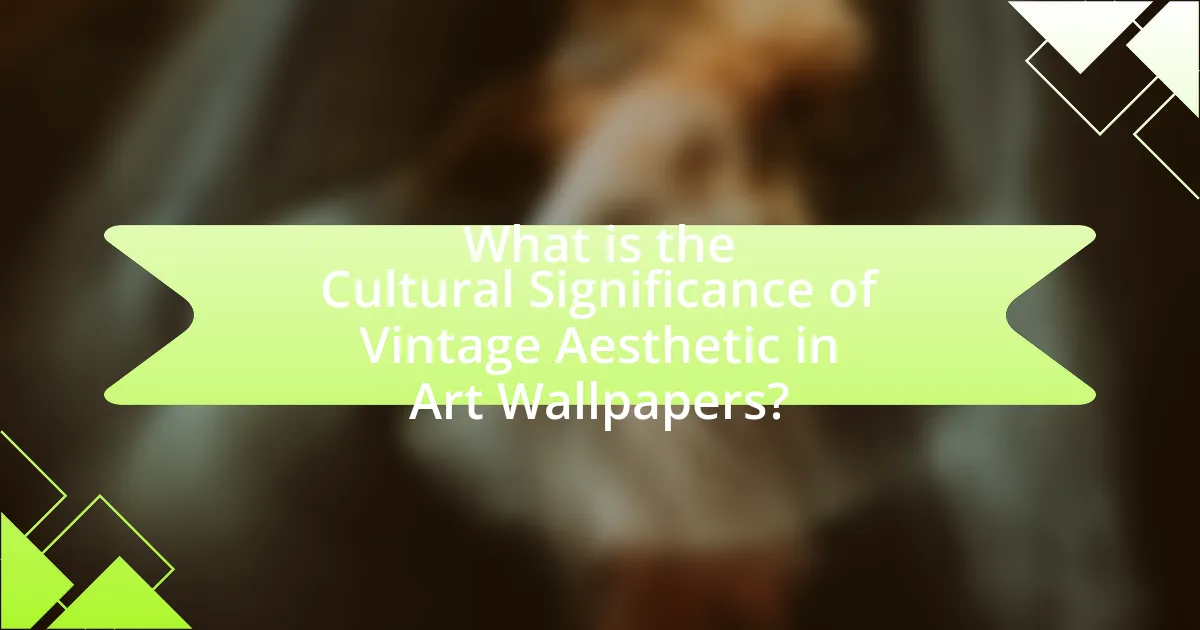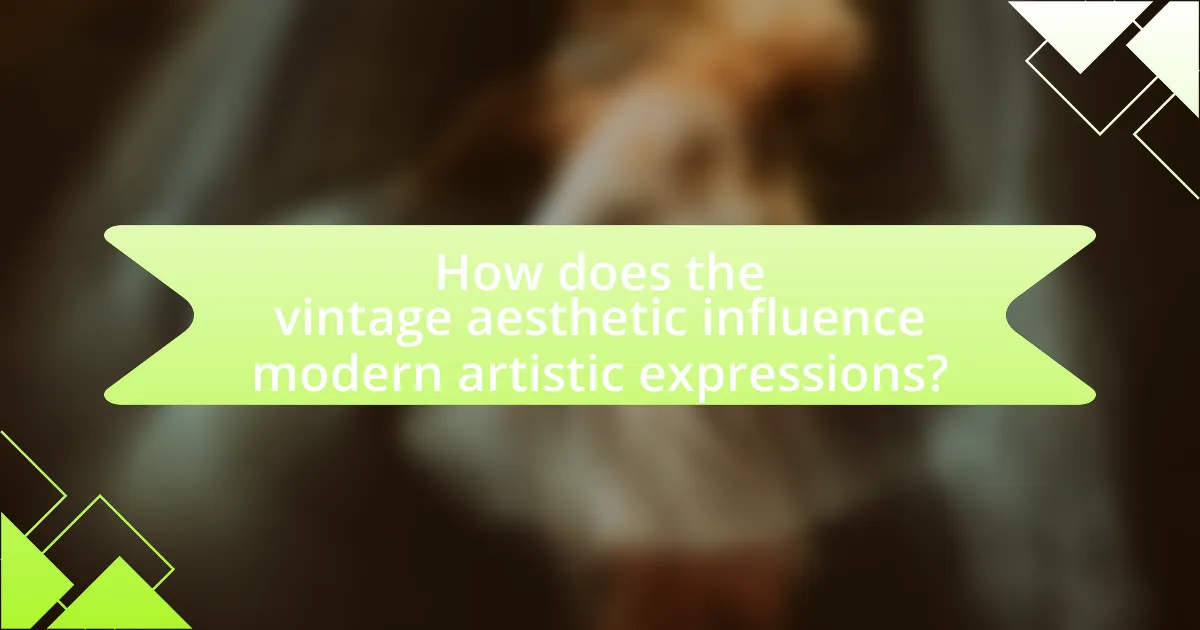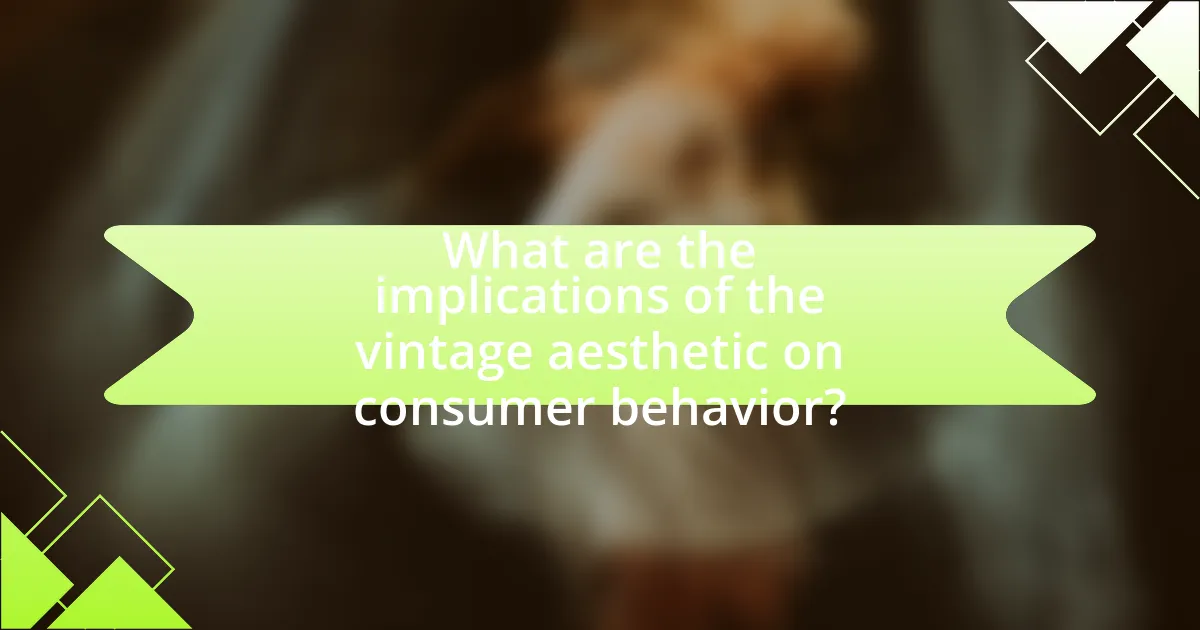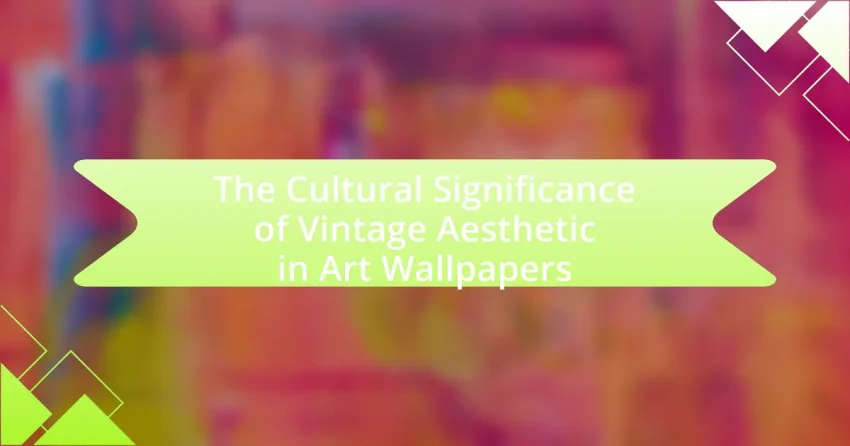The article explores the cultural significance of the vintage aesthetic in art wallpapers, highlighting its role in evoking nostalgia and connecting contemporary society with historical artistic movements. It examines the emergence of this aesthetic, influenced by styles such as Art Deco, Victorian, and the Arts and Crafts Movement, and discusses how these designs reflect societal values and trends. The article also addresses the psychological effects of vintage aesthetics on consumer behavior, the implications for interior design, and the techniques used to achieve a vintage look in modern wallpapers, ultimately illustrating how vintage art wallpapers serve as a bridge between past and present artistic expressions.

What is the Cultural Significance of Vintage Aesthetic in Art Wallpapers?
The cultural significance of vintage aesthetic in art wallpapers lies in its ability to evoke nostalgia and connect contemporary society with historical artistic movements. This aesthetic often draws inspiration from styles such as Art Deco, Victorian, and mid-century modern, reflecting the values and aesthetics of those eras. For instance, the resurgence of floral patterns and muted color palettes in vintage wallpapers can be traced back to the Arts and Crafts movement, which emphasized craftsmanship and a return to nature. This connection to history not only enriches the visual landscape of modern interiors but also fosters an appreciation for the craftsmanship and design philosophies of the past, making vintage wallpapers a cultural bridge between generations.
How did the vintage aesthetic emerge in art wallpapers?
The vintage aesthetic in art wallpapers emerged as a response to the growing appreciation for historical design elements and nostalgia for past eras. This trend gained momentum in the late 20th century, particularly during the 1960s and 1970s, when artists and designers began to draw inspiration from earlier styles, such as Art Nouveau and Victorian patterns. The revival was fueled by a cultural shift towards valuing craftsmanship and individuality, contrasting with the mass production of contemporary designs. The incorporation of vintage motifs, such as floral patterns and intricate detailing, became popular as they evoked a sense of warmth and familiarity, appealing to consumers’ desire for personal expression in their living spaces.
What historical movements influenced the vintage aesthetic in wallpapers?
The vintage aesthetic in wallpapers was primarily influenced by the Arts and Crafts Movement, Art Nouveau, and the Victorian Era. The Arts and Crafts Movement, which emerged in the late 19th century, emphasized handcrafted quality and natural forms, leading to intricate designs that celebrated nature. Art Nouveau, flourishing from the 1890s to the early 1900s, introduced flowing lines and organic motifs, which became prominent in wallpaper designs. Additionally, the Victorian Era, known for its ornate and eclectic styles, contributed to the richness of wallpaper patterns, often featuring floral and damask designs. These movements collectively shaped the vintage aesthetic by prioritizing artistry, craftsmanship, and nature-inspired themes in wallpaper design.
How has the definition of vintage evolved over time in art?
The definition of vintage in art has evolved from a focus on age and rarity to encompass broader cultural and aesthetic values. Initially, vintage referred primarily to artworks that were at least 20 to 100 years old, emphasizing their historical significance and craftsmanship. Over time, particularly in the late 20th century, the term began to include works that evoke nostalgia or a specific style associated with past eras, regardless of their actual age. This shift reflects a growing appreciation for retro aesthetics and the influence of popular culture, as seen in movements like mid-century modernism and the resurgence of vintage-inspired designs in contemporary art. The evolution of vintage in art highlights its role in shaping cultural identity and consumer trends, as artists and designers increasingly draw inspiration from past styles to create new works that resonate with modern audiences.
Why is the vintage aesthetic important in contemporary art wallpapers?
The vintage aesthetic is important in contemporary art wallpapers because it evokes nostalgia and connects viewers to historical art movements. This aesthetic draws on design elements from past eras, such as intricate patterns and muted color palettes, which resonate with audiences seeking authenticity and emotional depth in their environments. Research indicates that incorporating vintage styles can enhance the perceived value of a space, as seen in studies showing that consumers often associate vintage designs with quality and craftsmanship. Thus, the vintage aesthetic not only enriches contemporary art wallpapers but also fosters a deeper cultural appreciation and engagement with art history.
What cultural narratives are expressed through vintage art wallpapers?
Vintage art wallpapers express cultural narratives that reflect historical aesthetics, social values, and artistic movements of their time. These wallpapers often showcase motifs and designs that embody the ideals of specific eras, such as the romanticism of the Victorian period or the bold patterns of the Art Deco movement. For instance, floral patterns prevalent in the 19th century symbolize a connection to nature and domesticity, while geometric designs from the 1920s represent modernity and industrial progress. The use of color and form in these wallpapers also conveys cultural attitudes towards beauty and craftsmanship, illustrating how societies have evolved in their artistic expressions.
How does the vintage aesthetic reflect societal values and trends?
The vintage aesthetic reflects societal values and trends by emphasizing nostalgia, craftsmanship, and a longing for simpler times. This aesthetic often emerges during periods of rapid technological advancement or social change, as individuals seek comfort in the familiar and the past. For instance, the resurgence of vintage styles in fashion and interior design during the 2000s and 2010s coincided with economic uncertainty, highlighting a collective desire for stability and authenticity. Additionally, the vintage aesthetic promotes sustainability by valuing reused and repurposed materials, aligning with contemporary environmental concerns. This connection to sustainability is evident in the popularity of thrift shopping and upcycling, which have become significant trends in modern consumer behavior.
What role do vintage art wallpapers play in interior design?
Vintage art wallpapers serve as a significant element in interior design by adding character, depth, and historical context to spaces. These wallpapers often feature intricate patterns and designs that reflect artistic movements from the past, such as Art Deco or Victorian styles, which can evoke nostalgia and create a unique atmosphere. Their use can transform a room, making it feel more inviting and personalized, while also serving as a conversation starter. The incorporation of vintage art wallpapers can enhance the overall aesthetic by harmonizing with other design elements, thus contributing to a cohesive interior theme.
How do vintage wallpapers enhance the ambiance of a space?
Vintage wallpapers enhance the ambiance of a space by adding character, depth, and a sense of history. These wallpapers often feature intricate designs and patterns that evoke nostalgia, creating a warm and inviting atmosphere. For instance, studies show that spaces adorned with vintage elements can increase emotional well-being and comfort, as they connect individuals to past eras and memories. The unique textures and colors of vintage wallpapers can also influence light and shadow in a room, further enriching the overall aesthetic experience.
What are the psychological effects of using vintage aesthetics in home decor?
Using vintage aesthetics in home decor can evoke feelings of nostalgia, comfort, and identity. This psychological effect stems from the association of vintage items with positive memories and a sense of belonging, as they often remind individuals of past experiences or cultural heritage. Research indicates that nostalgia can enhance mood and increase feelings of social connectedness, as noted in the study “Nostalgia: A Psychological Resource” by Wildschut et al. (2006), published in the Journal of Personality and Social Psychology. Furthermore, vintage aesthetics can create a calming environment, as the warm colors and familiar designs often found in vintage decor can reduce stress and promote relaxation. Thus, incorporating vintage elements into home decor not only enhances aesthetic appeal but also positively influences emotional well-being.

How does the vintage aesthetic influence modern artistic expressions?
The vintage aesthetic significantly influences modern artistic expressions by inspiring contemporary artists to incorporate retro elements, styles, and themes into their work. This influence is evident in various art forms, including graphic design, fashion, and interior decor, where artists often draw upon nostalgic motifs and color palettes reminiscent of past decades. For instance, the resurgence of mid-century modern design in wallpapers and textiles reflects a broader trend where artists seek to evoke feelings of nostalgia and warmth, appealing to audiences’ emotional connections to history. Additionally, studies show that the vintage aesthetic can enhance consumer engagement, as seen in the popularity of vintage-inspired branding, which often leads to increased sales and brand loyalty.
What are the key characteristics of vintage aesthetic in art wallpapers?
The key characteristics of vintage aesthetic in art wallpapers include intricate patterns, muted color palettes, and nostalgic themes. Intricate patterns often feature floral designs, damask motifs, or geometric shapes that reflect historical design trends from the 18th to mid-20th centuries. Muted color palettes typically consist of soft pastels or earthy tones, evoking a sense of warmth and comfort associated with bygone eras. Nostalgic themes often draw inspiration from historical events, cultural movements, or artistic styles, such as Art Deco or Victorian influences, which resonate with a sense of heritage and timelessness. These characteristics collectively contribute to the vintage aesthetic’s appeal in interior design, creating spaces that feel both unique and historically rich.
How do color palettes contribute to the vintage aesthetic?
Color palettes significantly contribute to the vintage aesthetic by evoking nostalgia through specific hues and tones that reflect historical periods. These palettes often include muted colors, such as faded pastels or earthy tones, which mimic the appearance of aged materials and evoke a sense of time-worn beauty. For instance, the use of sepia tones and soft, desaturated colors in vintage wallpapers creates an atmosphere reminiscent of early 20th-century design, appealing to emotions tied to memory and history. This connection is reinforced by the fact that color choices in vintage aesthetics often draw from the color trends of specific eras, such as the Art Deco movement’s use of rich jewel tones or the 1970s’ preference for warm, earthy shades.
What patterns and motifs are commonly found in vintage wallpapers?
Common patterns and motifs found in vintage wallpapers include floral designs, damask patterns, geometric shapes, and toile prints. Floral designs often feature intricate, large-scale blooms and vines, reflecting the natural world and romantic aesthetics popular in the 18th and 19th centuries. Damask patterns, characterized by their elaborate, woven appearance, were frequently used in formal settings, showcasing elegance and sophistication. Geometric shapes, prevalent in mid-century modern designs, emphasize clean lines and symmetry, representing a shift towards minimalism. Toile prints, depicting pastoral scenes or historical narratives, provide a storytelling element that connects to cultural heritage. These motifs not only enhance the visual appeal of interiors but also reflect the artistic movements and societal values of their respective eras.
In what ways do artists incorporate vintage aesthetics into their work?
Artists incorporate vintage aesthetics into their work by utilizing design elements, color palettes, and motifs that evoke historical styles. For instance, they often draw inspiration from specific eras such as the Art Deco or Mid-Century Modern periods, employing geometric patterns and muted color schemes characteristic of those times. Additionally, artists may use techniques like distressed finishes or sepia tones to create a sense of nostalgia, which is a hallmark of vintage aesthetics. This approach is supported by the popularity of retro-themed exhibitions and the resurgence of vintage-inspired fashion, indicating a cultural appreciation for past styles.
How do contemporary artists reinterpret vintage styles in their creations?
Contemporary artists reinterpret vintage styles by integrating historical aesthetics with modern techniques and themes. They often draw inspiration from past art movements, such as Art Deco or Mid-Century Modern, and incorporate elements like color palettes, patterns, and textures that evoke nostalgia. For instance, artists may use digital tools to recreate the intricate designs of vintage wallpapers while infusing contemporary motifs or social commentary, thus bridging the gap between eras. This approach not only honors the original styles but also reflects current cultural narratives, making vintage aesthetics relevant in today’s art scene.
What techniques are used to achieve a vintage look in modern wallpapers?
Techniques used to achieve a vintage look in modern wallpapers include distressed finishes, muted color palettes, and intricate patterns reminiscent of historical designs. Distressed finishes create an aged appearance by simulating wear and tear, while muted color palettes often feature soft, faded hues that evoke nostalgia. Additionally, intricate patterns, such as damasks or florals, are frequently inspired by vintage styles, enhancing the overall aesthetic. These techniques are validated by design trends that emphasize the revival of retro aesthetics in contemporary interior design, reflecting a cultural appreciation for the past.

What are the implications of the vintage aesthetic on consumer behavior?
The vintage aesthetic significantly influences consumer behavior by evoking nostalgia and a sense of authenticity. This aesthetic often leads consumers to prefer products that reflect historical styles, which can enhance emotional connections and perceived value. Research indicates that nostalgia can increase consumers’ willingness to pay, as seen in a study published in the Journal of Consumer Research, where participants showed a higher preference for vintage items over modern alternatives due to emotional resonance. Additionally, the vintage aesthetic often aligns with sustainable consumption trends, as consumers are increasingly drawn to second-hand and upcycled products, further shaping purchasing decisions.
How does nostalgia influence the popularity of vintage art wallpapers?
Nostalgia significantly influences the popularity of vintage art wallpapers by evoking emotional connections to the past. This emotional resonance often leads consumers to seek out designs that remind them of earlier eras, creating a sense of comfort and familiarity. Research indicates that nostalgia can enhance consumer preferences, as seen in a study published in the Journal of Consumer Research, which found that nostalgic feelings can increase the desire for products that reflect past styles. Consequently, vintage art wallpapers, characterized by their unique patterns and historical significance, become appealing choices for individuals looking to recreate a sense of nostalgia in their living spaces.
What demographic trends are associated with the preference for vintage aesthetics?
Individuals aged 18 to 35 show a strong preference for vintage aesthetics, driven by nostalgia and a desire for authenticity. This demographic trend is evident in the popularity of vintage-inspired fashion, home decor, and art, reflecting a cultural shift towards valuing past styles. Research indicates that millennials and Gen Z consumers are increasingly drawn to vintage items, with a 2021 survey by ThredUp revealing that 70% of young adults prefer shopping second-hand for sustainability and uniqueness. Additionally, urban populations tend to embrace vintage aesthetics more than rural counterparts, influenced by access to vintage shops and online marketplaces.
How do marketing strategies leverage the vintage aesthetic to attract consumers?
Marketing strategies leverage the vintage aesthetic to attract consumers by evoking nostalgia and creating an emotional connection with the target audience. This approach taps into consumers’ memories and feelings associated with past eras, making products feel more relatable and desirable. For instance, brands often use retro designs, color palettes, and typography reminiscent of specific historical periods to create a sense of authenticity and uniqueness. Research indicates that nostalgia can enhance consumer preferences and increase willingness to pay, as seen in a study published in the Journal of Consumer Research, which found that nostalgic advertising can lead to higher purchase intentions. By integrating vintage elements into their branding and product design, companies effectively differentiate themselves in a crowded market and foster brand loyalty among consumers who appreciate the charm and character of vintage aesthetics.
What are the best practices for incorporating vintage aesthetics in modern spaces?
To effectively incorporate vintage aesthetics in modern spaces, one should blend vintage elements with contemporary design to create a cohesive look. This can be achieved by selecting key vintage pieces, such as furniture or decor, that serve as focal points while ensuring that the surrounding modern elements complement rather than clash with them. For instance, pairing a mid-century modern chair with a minimalist table can highlight the vintage piece without overwhelming the space.
Additionally, using vintage-inspired wallpapers can enhance the aesthetic; patterns reminiscent of past eras can evoke nostalgia while maintaining a fresh feel. Research indicates that vintage design elements can enhance emotional well-being, as they often evoke memories and a sense of comfort. Therefore, incorporating vintage aesthetics not only enriches the visual appeal of modern spaces but also contributes positively to the atmosphere.
How can one effectively mix vintage wallpapers with contemporary decor?
To effectively mix vintage wallpapers with contemporary decor, one should select a vintage wallpaper that complements the color palette and style of the contemporary elements. This approach creates a cohesive look, allowing the vintage wallpaper to serve as a focal point while harmonizing with modern furnishings. For instance, pairing a bold floral vintage wallpaper with minimalist furniture can create a striking contrast that enhances both styles. Historical design principles indicate that contrasting styles can evoke a sense of depth and interest in a space, as seen in various interior design case studies.
What tips can help in selecting the right vintage wallpaper for a space?
To select the right vintage wallpaper for a space, consider the overall aesthetic and color scheme of the room. Vintage wallpapers often feature distinct patterns and colors that can either complement or clash with existing decor. For instance, a floral pattern may enhance a rustic or traditional setting, while geometric designs can suit modern interiors. Additionally, assess the condition of the wallpaper; authentic vintage pieces should be free from significant damage or fading to maintain their visual appeal. Historical context is also important; understanding the era of the wallpaper can help ensure it aligns with the intended style of the space. For example, Art Deco wallpapers from the 1920s often feature bold colors and geometric shapes, which can add a striking element to a contemporary room.
